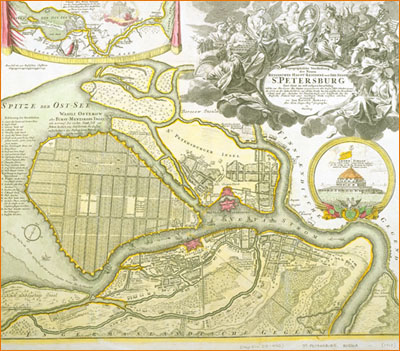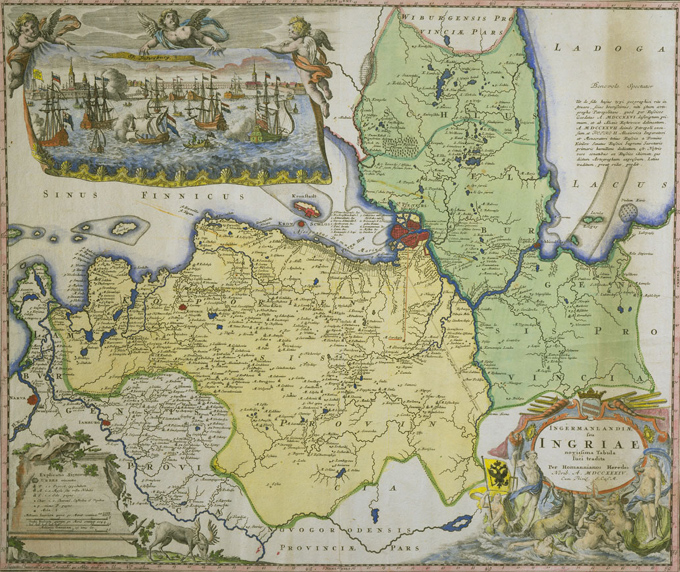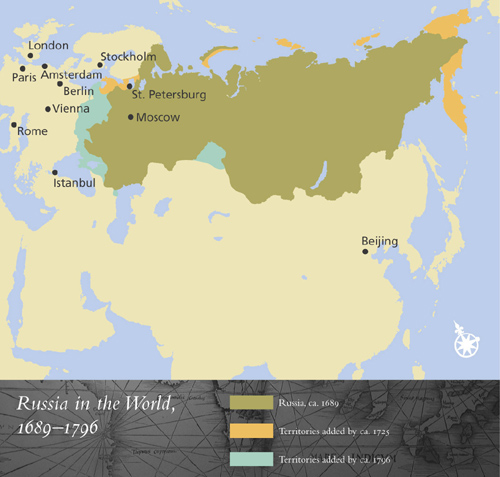By Hudson Rowland
Introduction
In the 17th Century, Russia was considered to be a backwards, and barbaric country in the eyes of the major powers in Europe. However, after the rule of Peter the Great, this view changed and Russia was no longer seen as a backwards nation stuck in medieval times, but rather as a major player in the Balance of Power in Europe. The time period that this Research Guide will focus on are the years in which Peter the Great was in power and the next half-century after his death, starting with the year he takes up power in 1682 and ending in 1800 (so as to give us some time to examine his legacy after his death in 1725).

Created by an Italian artist named Bartolomeo Rastrelli using a wax molding mask of Peter the Great's actual face in 1719
Before Peter the Great came into power though, Russia was in fact modernizing. In other words, he was not the beginning of change in Russia in the 16th Century; however, there were many policies he put into effect to aid in these changes. The goal behind this Research Guide is to discover what these changes were and what forces Peter the Great put into effect in order to strengthen them. Through this guide, we will uncover who Peter the Great was as a person, what actions he took to modernize Russia, and how Russia changed as a result of his actions. This guide includes primary sources, books analyzing his rule, and online articles and encyclopedias in order to understand Peter the Great’s mark in history.
Introductory Sources
Klyuchevsky, Vasili. Peter the Great. New York: St Martin’s Press, 1969
Provides a good introduction to who Peter the Great was as a person in the beginning of this book. The focus of the book, however, is on the social and administrative changes that occurred under his rule. A good resource for understanding what actions Peter the Great took in order to modernize Russia.
Anderson, M. S. Peter the Great. London: Longman, 1995.
Anderson provides a great biography of Peter the Great and is an excellent place to start research from. The biography includes what Russia was like before Peter the Great came into power, an overview of the policies he put into effect, and the wars that he fights in and what he learns from them.
Sumner, Benedict H. Peter the Great and the emergence of Russia. London. 1962
This book offers some great information regarding the reforms that took place under Peter the Great. Sumner discusses reform in the Civil Government and Religion as well as the social and economic changes. There is some background information in the beginning chapters of the book, some of it is useful but is lengthy. I would suggest another source for background.
Dmytryshyn, Basil ed. Modernization of Russia Under Peter I and Catherine II. New York: John Wiley & Sons, Inc., 1974.
While only half of the book focuses on Peter the Great, it is still a great resource in discovering what actions he took to modernize Russia. This book provides administrative decrees issued by Peter the Great as well as multiple assessments of his modernization.
Policies and Methods
An excellent source describing an anecdote of when Peter the Great made a trip to England where he meets with the religious group, the Quakers. Shows Peter the Great desire to learn more about the western world and how this meeting influenced his policies on religion in Russia.
Gives information on some of the books that Peter the Great had in his possession and how they influenced his decisions and gave him ideas. By examining the books he had in his collection we can gain a better understanding of what ideas were being presented to him and how he used the knowledge available in these books to pick and choose what he should do as a ruler.
The Illustrated Magazine of Art , Vol. 4, No. 19 (1854).
Provides several anecdotes of who Peter the Great was as a person and specific cases of events that lead to the change in many of Russia’s policies. Though it is a useful source, it can be a bit difficult to understand at times when the article switches between the narrative and anecdote. However, this is a minor detail that can be overlooked.
Leonid Alekseyevich Nikiforov, “Peter I,” Britanica Academic Edition
Gives an overview of Peter the Great’s life as a youth and as a ruler. Goes into detail the policies he implements and the wars that he undertakes in order to increase Russia’s standing in the eyes of the rest of the European Powers.
“Peter the Great: 18th Century,” State Hermitage Museum, 2011
Provides a good source of images of objects and people that are representative of the changes that Peter the Great put into effect in order to modernize Russia. Shows change in how Peter the Great wanted Russia to be viewed and how he wanted himself to be viewed.
“Peter the Great, reigned 1682-1725,” Royal Museums Greenwich, 1 Feb 2000
A good source focusing mainly on Peter the Great’s modernization in the field of Naval Power. This article discusses how one of Peter the Great’s biggest goals for his trips to Europe was to discover modern ship building techniques so he could build Russia’s first navy.
A good source containing multiple primary source documents describing the technological advancement that Russia was making under Peter the Great. Describes how massive projects like building railroads or a fleet were undertaken at the time showing an in increase in modernization, for before Peter the Great, Russia had no navy and therefore no great ability to trade by sea (something essential in order to be considered a modern state)
“4. Peter the Great.” Youtube. 2 Sep 2009.
An excellent lecture discussing not only the reforms in the military that lead to Russia’s territorial expansion but also on internal politics and the integration of Western ideals.
Legacy of Peter the Great
Cross, Anthony. Peter the Great through British Eyes: Perceptions and Representations of the Tsar since 1698. Cambridge: Cambridge University Press, 2000.
Anthony Cross offers a great documentation and analysis of Peter the Great’s visit to England in 1698. The various types of primary sources exhibit the changing view on Peter the Great from the perspective of the British at the time of his visit and long after his death up until the 19th Century.
Riasanovysky, Nicholas V. The Image of Peter the Great in Russian History and Thought. New York: Oxford University Press, 1985.
Through Riasanovysky’s book, we find a new outlook on Peter the Great from the perspective of the different periods of thought that follow his death. Essentially this book focuses more on the legacy Peter the Great left behind and how people in Russia viewed him up until the late 20th Century. This book is filled with primary sources from each time period that is examined.
“Modern History Sourcebook: Peter the Great and the Rise of Russia, 1682-1725,” Fordham University
A short collection of primary sources describing how Peter the Great was perceived from the perspective of four individuals. Provides a good image of who Peter the Great was as a person and what his goals and interests were.
“Peter the Great and his Legacy (1682-1762),” New York Public Library
A good source for a quick overview of Peter the Great’s life, accomplishment, and legacy. Also provides multiple pieces of Artwork that depict him and the actions he takes to modernize Russia. Goes into detail about each picture describing the meaning behind each picture.
Maps and Charts

A German depiction of St. Petersburg in 1718. Peter the Great killed thousands to build this city as fast as possible
Some main events in Peter the Great’s Life
| 1672 | Peter the Great is born. |
| 1676 | Peter’s father, Tsar Alexis dies, and Peter’s half-brother Feodor becomes Tsar. |
| 1682 | Feodor dies and Sophia becomes regent on behalf of her younger half-brothers. |
| 1688 | Peter begins his first attempts at shipbuilding, on a lake. |
| 1689 | Peter marries Evdokia Lopukhina, his first wife. |
| 1693 | Peter sees the sea for the first time. His passion for ships and sailing is to last throughout his life. |
| 1696 | Ivan, Peter’s half-brother dies. Peter begins to build up a navy. |
| 1697–98 | Peter leads his Great Embassy to western Europe, visiting the Netherlands, Vienna and England. |
| 1703 | Peter orders the building of a new city to be named St. Petersburg. |
| 1707 | Peter marries Catherine, his second wife privately. The marriage to his first wife, banished to become a nun, is declared null and void. |
| 1717 | Peter visits Europe again, travelling to the Netherlands and Paris. |
| 1718 | Alexis, Peter’s son, dies in mysterious circumstances after attempting to escape from his father. |
| 1724 | Peter’s second wife Catherine, is crowned as empress. |
| 1725 | Peter dies, after contracting a fever several months earlier. |
| 1727 | Catherine rules after the death of Peter. |
| 1727 | Catherine dies and Peter’s grandson becomes Tsar Peter II. |


